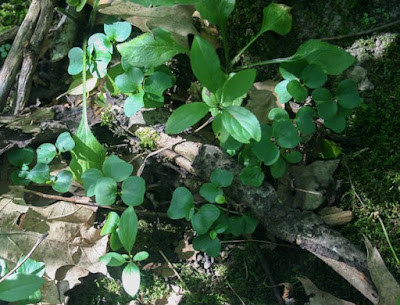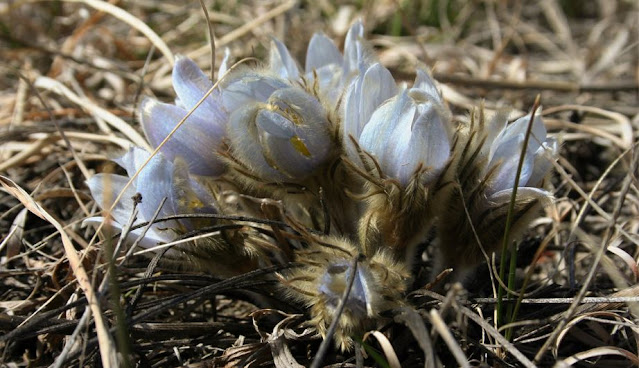 |
| Red elderberry, Sambucus racemosa, breaks it buds in early spring. Its phenology makes it a potential competitor with common buckthorn, Rhamnus cathartica. |
One of the frustrations of removing common buckthorn (Rhamnus cathartica), is that it keeps coming back. Cut stems that aren’t treated with herbicide will sprout multiple shoots, and in areas where buckthorn has been removed, more sunlight is available to support the growth of sprouts and seedlings.
Controlling buckthorn then requires repeated visits to cut, re-treat
or pull up the plants. Buckthorn seeds remain viable in the soil for up to five
years, so several trips are necessary to remove seedlings and young plants. Even
after the buckthorn seed bank is exhausted, nearby stands provide additional
sources. Birds that eat the fruits can drop seeds into the treated area, turning
buckthorn control into an ongoing project.
 |
| Buckthorn seedlings thrive where higher light intensity reaches the forest floor. |
Recognizing these challenges, scientists at the University
of Minnesota are looking at a new way to manage this invasive plant. Instead of
investigating mechanical or chemical controls, their research, called the Cover
It Up study, asks whether native plants can thwart recolonization by exploiting
buckthorn’s weakness: shade intolerance.
One of the plants in their study is red elderberry (Sambucus
racemosa), a common understory shrub. Contrary to the perception that
buckthorn leafs out earlier and retains leaves later than any native plant, elderberry
is one of the earliest plants to resume growth in spring – even earlier than
buckthorn. It also holds its leaves well into fall, rivaling buckthorn as the
understory plant with the latest senescence.
That extended phenology suggests that both buckthorn and red
elderberry are shade-avoidant, not shade tolerant. In fact, co-principal
investigator Michael Schuster and his colleagues found that buckthorn growth is
linked to light availability in spring and fall, but not in summer (1).
Schuster and others also think that forests with a diverse understory can
better resist invasion, because species with extended phenologies, like red
elderberry, can block light from reaching buckthorn during those critical seasons
(2).
Phase 2 of the Cover It Up study began in 2020. This
expanded part of the research enrolled citizen scientists across Minnesota to
remove buckthorn, establish experimental plots and sow seeds of native grasses,
sedges, wildflowers, shrubs and trees. Their aim is to see what techniques can
best prevent buckthorn recolonization in different parts of the state.
Phase 2 will conclude this year, and although it’s closed to
new volunteers, anyone interested in following the research can subscribe to
the quarterly project
newsletter.
For more information about the Cover It Up study, including
a list of species included in the Phase 2 seed mix, visit the project website
at https://coveritup.umn.edu/. The
seed list is under the Resources tab.
To learn how to identify buckthorn
and how it harms ecosystems, visit these sites:
Minnesota DNR
Minnesota Department of Agriculture
Woody Invasives of the Great Lakes Collaborative
Finally, to learn how to identify
red elderberry, see the Minnesota
Wildflowers page for that species.
References
(1) Schuster MJ, Wragg PD, Williams LJ, Butler EE, Stefanski A,
Reich PB. 2020. Phenology matters: Extended spring and autumn canopy cover
increases biotic resistance of forests to invasion by common buckthorn (Rhamnus
cathartica). Forest Ecology and Management 464. https://doi.org/10.1016/j.foreco.2020.118067.
(2) Schuster MJ, Wragg PD, Reich PB. 2021. Phenological niche
overlap between invasive buckthorn (Rhamnus cathartica) and native woody
species. Forest Ecology and Management 498. https://doi.org/10.1016/j.foreco.2021.119568.




